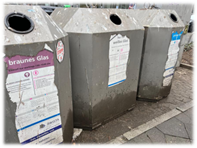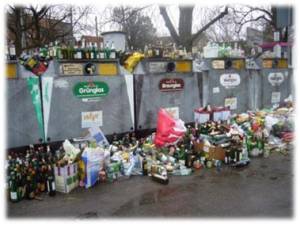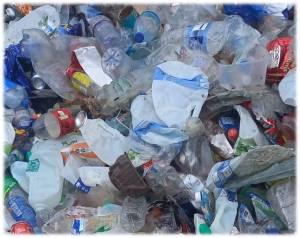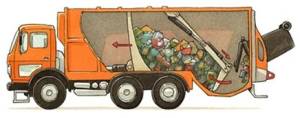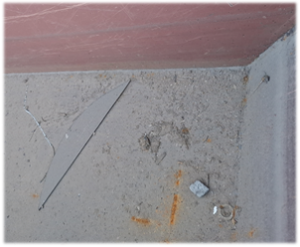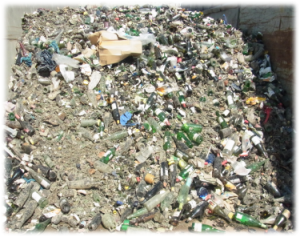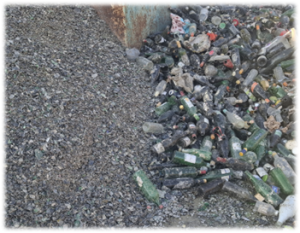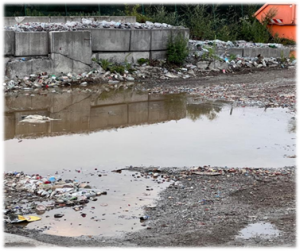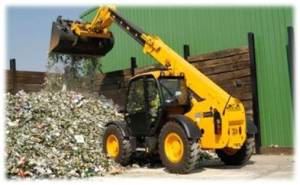The most common Mistakes in Glass Collection, Transportation and Storage
Collection
1 – Too few locations for bottle banks
The number of bottle bank locations frequently is not high enough in relation to the number of inhabitants or the collection volume. The municipalities determines theses places and the number of places.
2 – Wrong locations for bottle banks
Sometimes bottle banks are placed in streets or areas the consumer doesn’t pass or cannot reach conveniently. Containers are often located in the middle of nowhere and/or in dangerous places.
3 – Bottle banks without the required labels
Sometimes or after a while the labels wear off the bottle banks because of weather conditions, UV light, vandalism etc. Without clear and simple signage the customer does not know where to put the different glass containers and what does not belong into the packaging glass collection.
4 – Dirty and unkempt bottle banks and locations
A bottle bank location that is not tidy leads to littering and attracts other waste like household rubbish and bulky waste (old furniture, etc.)
5 – Frequency of emptying cycle too low
Especially in periods like New Years Eve, Christmas and carnival/festive periods the collection cycle has to be adapted and increased to meet the expected collection demand
6 – Wrong kind of glass collection system
The chosen collection system is extremely relevant for the effectiveness of the recycling loop and the quality of the final product.
Bottle banks are preferred but other ways of collection may be required depending on the circumstances like volume/year, space, traffic conditions, collection vehicle access, etc.
Comingled collections like glass + metal, MRF glass (glass from a Materials Recovery Facility), or glass in plastic bags lead to difficult recycling processes and high losses in the loop.
7 – Route planning of glass collection not optimal
The route for the collection truck has to be optimal depending on the circumstances.
Different fill levels of bottle banks require an intelligent routing for the truck. The drivers usually know their municipality area and its complexities which have to be noted for the planning of the collection sequence and frequency.
Loading of truck not always with required separation
In order to complete the full loading capacity of the truck some drivers just take the nearest next bottle bank without considering the right glass colour. This requires higher recycling efforts and higher losses in regard to colour separation.
8 – Replacing regular collection truck drivers with temporary substitute or new drivers
In case of vacation or illness of the original driver the substitute driver is not well informed about the route or special characteristics of the job. Sometimes there is no route plan or site-specific collection information for the new driver. The same for new collectors in the municipality.
9 – Poor or no public relations work
Without public relations the consumer doesn’t know what belongs into the packaging glass collection and what doesn’t. Each new generation needs to be informed and educated about the related knowledge about correct handling of glass waste.
Transportation
1 – Kind of collection truck not suitable
The collected glass has to be handled carefully to avoid too much breakage. Compaction trucks i.e. rear end loaders are not to be used.
2 – Loading spaces of trucks not clean and tidy
Previous other transport goods like metal scrap, minerals as well as internal trailer corroded surfaces lead to serious impurities in the final cullet product
3 – Reloading and transship too often
Each loading and unloading of packaging glass creates more broken bottles and jars.
This leads to so-called fines which requires higher recycling efforts and higher losses in regard to colour separation.
4 – No skilled staff watching the unloading at transfer points and recycling plant
Sometimes serious mistakes happen when drivers unload in wrong places or the wrong colour storage bay if no skilled persons like wheel loader drivers or groundsmen are present.
New drivers sometimes unload too fast and produce more broken glass than usual.
Storage
1 – bays with wrong size or overloaded
Due to cramped space conditions the bays are often too small and overloaded. The wheel loader is forced to push up the delivered infeed. This leads to more broken glass than usual.
2 – Transfer points unsuitable
Some operators of transfer points are not aware of the required cleanliness and characteristics of the storage surfaces and bay walls. The surface and the walls must be absolutely tidy and abrasion-resistant to avoid impurities ending up in the collected glass. Dry storage is advantageous.
3 – Unprofessional handling of collected glass
Some wheel loader drivers handle the fragile glass material unnecessarily roughly. This leads to needless additional breakage of the material.
Often movement of glass between two bays is not required and should be avoided were possible.
4 – Wrong wheel loader shovel size
The size of the shovel must fit into the truck and bay size in order to minimize breakage of the glass
5 – Wheel loader shovel not clean and tidy
If the wheel loader is handling different materials (i.e. metals, plastics, construction stuff …) at the transfer point, the driver must ensure that the shovel bucket is clean before handling glass



